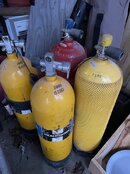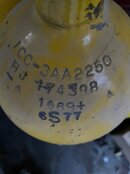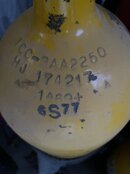Pitting and hydro are two different criteria for evaluating a tank's condition. Tanks that can be condemned for pitting can pass hydro (a test of the metal's elasticity) and vice versa. A hydro tester checks for pitting before/after hydro.
Fwiw i pass many ancient 72s but the ones that seem to fail are the "barn finds" that have been sitting with little to no pressure for years. Purely anecdotal and many "barn finds" pass hydro and go on to become productive members of the diving community.
I am no metalurgist but i would be interested to know what happens to the metal in tanks that are neglected for too long.
This is correct. A cylinder can actually be structurally capable of passing a hydro test, but still have a small diameter cavity deep enough to be a the verge of leaking through. It could also be very capable of passing a hydro test, but have enough corrosion to not make it to the next 5 year cycle.
For those reasons (and a few more) what we call a hydro test is not just a hydro test. It is really a “re-qualification procedure” that uses a hydro as part of the process.
Before the re-qualifying facility does the hydro they require by CFR (Code of Federal Regulations) to do a visual inspection and determine if the cylinder is fit to proceed to do a hydro. This is done by the DOT licensed facility and is not to be confused with the Scuba industry standard VIP.
A DOT facility can legally Reject or even Condemn a cylinder based on the visual inspection prior to the hydro.
The definition of both Reject and Condemn are specified in CFR. The short answer is that Reject means it can still be cleaned, tumbled, sand blasted, wire brush, etc. and re-inspected to determine if it is fit for hydro.
Condemn is normally final. The damage or imperfections are too severe to be re-qualified.
Again this is all supposed to be determined by a licensed DOT facility (and hopefully qualified).
Violations even for simple documentation errors can cost the facility some serious fines.
Note: by law no one is allowed to drill or damage the threads of a cylinder (unless you signed a relase in a dive shop, giving authorization) even if the cylinder in condemn. But a "licensed DOT re-qualifier" can cross out the DOT numbers by stamping XXX on it. The cylinder is personal property, but the numbers belong to the DOT. They better have good records showing why it was condemn. I have had 3 cylinders replaced by a hydro facility.
I am not a metallurgist either, but I have some working knowledge due to my structural engineering background, and I have dealt with a reasonable amount of steel (and aluminum). There is nothing particular to a barn or age that will affect the metallurgy of a pressure vessel, with a few exemptions.
The first is fire. Fire can and will totally ruin the heat treatment of both steel and aluminum cylinder. Aluminum is affected by relatively low temperatures, but a fire will also ruin a steel cylinder. The metallurgy is definitely affected by heat and in the case of aluminum the temperature can be low enough to leave no visible mark. Steel requires a hot fire that would normally leave some surface indications, but not always.
The only other thing that will typically ruin a pressure vessel is anything that will cause corrosion (inside or out). An empty cylinder in a barn can corrode inside or out.
Hay bales (as found in a barn) are actually very corrosive. Read story below.
Age alone doesn’t do anything to either metal, but it allows more time for corrosion… in a corrosive environment.
About hay bales and corrosion: This is my 32 year being a volunteer (mostly Sunday) ski patrol here in Maine. For over 10 years of patrolling we used to use hay bales as padding on front of the steel snow making water hydrants. The patrol used to deploy the hay bales from the summit using are toboggans. It was great recue toboggan training. Well that practice stopped when they started to find deep pits on the water pipes next to the hydrants. The pipes started leaking through pin holes.
Keep in mind our mountain elevation 1200 feet. The snow making water pressure required to make snow at the summit is over 520 psi.
It turns out that hay is fairly acidic. I though that was fairly interesting...








